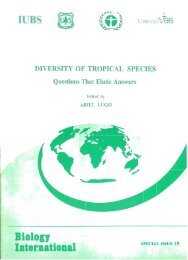SPECIAL ISSUE 34a.pdf - Biology International
SPECIAL ISSUE 34a.pdf - Biology International
SPECIAL ISSUE 34a.pdf - Biology International
Create successful ePaper yourself
Turn your PDF publications into a flip-book with our unique Google optimized e-Paper software.
Bioiogy <strong>International</strong>, SpeciaI Issue No. 34 (1997)<br />
that the author(s) include in the publication a description in a more familiar<br />
language" (BC Rec. 25a).<br />
(ii) Starting-point dates<br />
Differences in starting-point dates, although on the face of it an inherently self-<br />
contained matter, in that the different starting-point dates apply to different<br />
groups of organisms, can be of significance in determining the correct name of<br />
taxa that have been considered under more than one Code. 1 January 1758 is the<br />
starting-point for al1 names under the zoological Code (the date upon which<br />
both Linnaeus's Systema Naturae edition 10 and Clerck's Aranei Svecici are<br />
deemed to have been published, although the latter, covering the Arachnida,<br />
was actually published in 1757 and is given precedence over Linnaeus's<br />
publication), and 1 May 1753 for most groups under the botanical Code, but<br />
with nurnerous exceptions involving six different dates, ranging fiom 1801 for<br />
the mosses (Sphagnaceae excepted), through 1820 for al1 groups of fossil<br />
plants, to as late as 1900 for the algal family Oedogoniaceae. Until the Sydney<br />
Congress of 198 1, the starting-point dates for names of fungi were either 180 1<br />
(Uredinales (smuts), Ustilaginales (rusts) and Gasteromycetes) or 182 1 (al1<br />
other fungi), the dates of significant publications by Persoon (Synopsis method-<br />
ica fungorum) and Fries (Systema mycologicum), respectively; although the<br />
starting point is now the same as that of most other organisms covered by the<br />
botanical Code, these works are granted special status under a procedure known<br />
as sanctioning, analogous to conservation en bloc (see ICBN M. 15). Apart<br />
from the specific starting dates under the ICBN of 1 January 1886 and 1892 for<br />
the homo- and hetero-cystous Nostocaceae, respectively, which, as<br />
Cyanobacteria, some might wish to treat under the Bacteriological Code, with<br />
its starting-point date of 1 January 1980 (Rule 24a), divergence in starting-point<br />
date is unlikely to be a serious problem, as it Ca., in practice, only effect those<br />
few names of organisms that might be treated under the botanical or zoological<br />
Codes, that were published between 1753 and 1758.<br />
(iii) Mandatory designation of type<br />
Whereas the ICBN has required, since 1952, specific designation of a type for<br />
establishment (valid publication) of the name of a new taxon, this, although<br />
considered good zoological practice, has not hitherto been mandatory, although<br />
the provision will be included in the forthcoming fourth edition of the ICZN.<br />
The BC also makes designation of a type mandatory for effective publication<br />
(Rule 16). As this requirement has been a feature of the BC since its inception,<br />
that Code has no need for specific rules governing the designation of alter-<br />
natives to a holotype, as have the botanical and zoological Codes. Whereas the<br />
ICZN requires that the first choice of lectotype must be followed unless it can be<br />
shown that the designated specimen was not eligible (not being a syntype) (Art.<br />
74(a)), the ICBN can permit supersession of such a choice if the element chosen<br />
is in conflict with the protologue (i.e. the original description and associated<br />
material).




